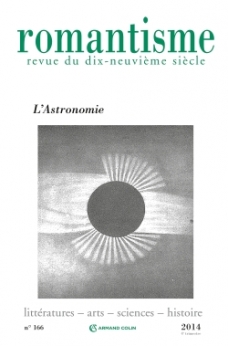
Romantisme n° 166 (4/2014)
Pour acheter ce numéro, contactez-nous
Recevez les numéros de l'année en cours et accédez à l'intégralité des articles en ligne.
Au travers des articles qu’il consacre aux travaux d’Amédée Guillemin, Émile Zola apparaît comme un heureux témoignage de la diffusion de la culture astronomique portée par les travaux de Camille Flammarion dans la seconde moitié du XIXe siècle. La conquête intellectuelle du ciel acquiert même une place stratégique dans le discours théorique zolien d’une quête inextinguible de la vérité dans l’art. Néanmoins, au-delà des manifestes explicites, la confrontation des personnages des Rougon-Macquart avec l’infini étoilé suggère un tout autre rapport de l’écrivain au ciel, celui-ci devenant une source d’angoisse, de perte de maîtrise de l’homme face à l’immensité brute et non signifiante de l’espace. Du discours affiché à son traitement dans la création romanesque, le motif astronomique appartient ainsi à ces fissures mettant en crise la doxa zolienne de conquête du réel par la littérature.
Through the articles he dedicated to the works of Amédée Guillemin, Émile Zola cuts a figure as a witness favourable to the diffusion of astronomical culture as practiced by Camille Flammarion in the second half of the 19th century. The intellectual conquest of the heavens even acquires a strategic role in the Zolian discourse of the everlasting quest for truth in art. Nonetheless, beyond its explicit manifestations, the confrontation of the characters from the Rougon-Macquart with the star-specked infinity suggest a different relationship of the writer to the heavens, the latter becoming a source of anxiety, of loss of mastery for man confronted with the meaninglessness of the immensity of brute space. Thus the astronomical motif, with the gap its presents between a discourse favourable to it and its treatment within the space of the novel, is one of the cracks through which the crisis of the Zolian doxa of the conquest of reality through literature shows itself.

